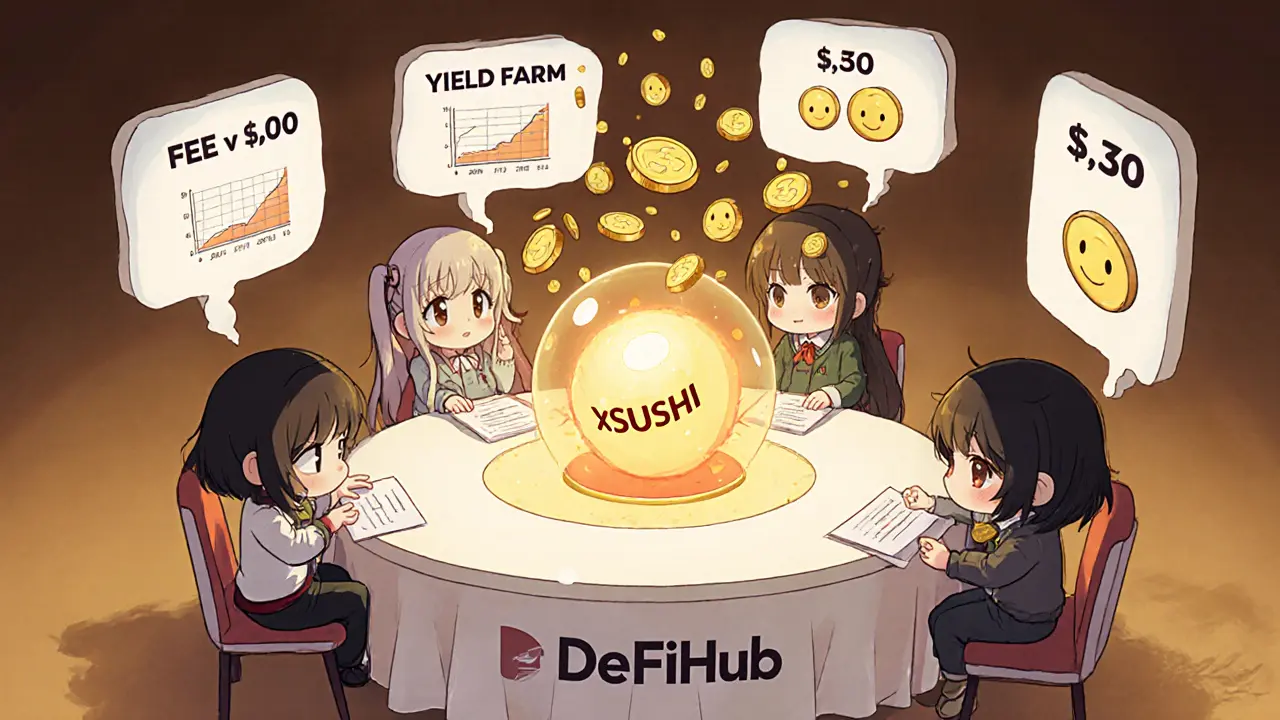SushiSwap Polygon Fee Calculator
Calculate how much you'd save by swapping on Polygon instead of Ethereum. The calculator shows fee differences based on current network conditions.
When you’re tired of paying $30 in gas fees just to swap ETH for USDC, SushiSwap on Polygon feels like a breath of fresh air. It’s not just cheaper-it’s faster, smoother, and packed with tools most centralized exchanges don’t even offer. But is it actually worth your time? Or is it just another DeFi platform with too many menus and not enough clarity?
What SushiSwap on Polygon Actually Does
SushiSwap on Polygon isn’t a separate app. It’s the same SushiSwap protocol you know from Ethereum, but running on Polygon’s Layer 2 network. That means you get all the core features-swapping tokens, staking, earning yield-but without the insane fees and slow confirmations of Ethereum mainnet.
Unlike centralized exchanges like Binance or Coinbase, SushiSwap doesn’t hold your crypto. You keep your keys. Trades happen directly between users through smart contracts using liquidity pools. If you want to trade MATIC for DAI, you’re not placing an order-you’re swapping against a pool of other people’s funds. It’s automated, transparent, and trustless.
The SUSHI token is the heartbeat of the system. It’s not just a trading pair-it’s your voting card. Holders can propose changes, vote on upgrades, and even earn extra rewards by locking SUSHI into xSUSHI. As of October 2025, SUSHI trades at $2.19 with a market cap of $574 million. That’s a long way from its $23 high in 2021, but it’s still one of the most active governance tokens in DeFi.
Why Polygon Makes All the Difference
Running SushiSwap on Ethereum used to be a gamble. During bull runs, fees would spike to $50 per swap. Transactions took minutes. Sometimes they failed. Polygon changed all that.
On Polygon, swapping tokens costs between $0.01 and $0.10. That’s not a typo. A typical trade that would’ve cost you a coffee on Ethereum now costs less than a candy bar. Confirmations happen in 2-3 seconds-not 15, not 30. You can make five swaps in the time it takes to check your email.
Polygon’s speed and low cost turned SushiSwap from a niche tool into a daily driver. As of 2025, 30-40% of all SushiSwap volume happens on Polygon. That’s not small-it’s the main reason the platform still has traction in a crowded DeFi space.
What You Can Do Beyond Swapping
Most DEXes stop at swapping. SushiSwap doesn’t. On Polygon, you can:
- Swap tokens-any ERC-20 token you can find, from stablecoins to obscure memecoins.
- Stake SUSHI-lock it up to earn xSUSHI, which gives you a share of trading fees and voting power.
- Join yield farms-provide liquidity to token pairs and earn extra SUSHI rewards on top of trading fees.
- Lend and borrow-through Sushi’s integrated lending protocol, you can use your crypto as collateral.
This isn’t just a DEX. It’s a full DeFi hub. If you’re someone who wants to earn passive income from your crypto without handing it over to a centralized exchange, SushiSwap on Polygon gives you the tools. But it also means you need to understand what you’re doing. Yield farming isn’t free money-it comes with risks like impermanent loss, which can wipe out your gains if prices swing too hard.

How It Compares to Other Polygon DEXes
QuickSwap is the native DEX of Polygon. It’s simpler, faster to load, and built specifically for the chain. Uniswap V3 on Polygon is more efficient for large trades thanks to concentrated liquidity. So where does SushiSwap fit in?
Here’s the breakdown:
| Feature | SushiSwap | QuickSwap | Uniswap V3 |
|---|---|---|---|
| Trading fees | $0.01-$0.10 | $0.01-$0.05 | $0.01-$0.10 |
| Speed | 2-3 seconds | 2 seconds | 2-3 seconds |
| Yield farming | Yes | Yes | No |
| Staking (xSUSHI) | Yes | No | No |
| Governance (SUSHI voting) | Yes | No | No |
| Lending/Borrowing | Yes | No | No |
| Best for | DeFi power users | Simple swaps | Large trades |
If you just want to swap MATIC for USDT and get out, QuickSwap is cleaner. If you’re trading big amounts and want the tightest price slippage, Uniswap V3 wins. But if you want to earn, vote, lend, and farm-all in one place-SushiSwap is still the only one that offers it all.
Who Should Use It-and Who Should Skip It
SushiSwap on Polygon isn’t for everyone. Here’s who it’s built for:
- You’ve used a wallet like MetaMask before.
- You understand what gas fees are (and why Polygon fixes them).
- You’re okay with reading a few help articles before staking your first token.
- You want to earn more than just trading fees-you want governance power.
It’s NOT for you if:
- You think crypto should be as easy as buying stocks on Robinhood.
- You don’t want to learn what impermanent loss means.
- You expect live chat support to fix your transaction in 10 minutes.
Most users who quit SushiSwap do so because they got scared by the interface. There are five tabs, three different staking options, and a bridge that takes seven days to unlock funds. It’s overwhelming. But once you use it for a week, it clicks. The key is to start small: swap $20 worth of tokens. Stake $10 in SUSHI. See how it feels.
The Risks You Can’t Ignore
There’s no such thing as risk-free DeFi. Here’s what you need to watch:
- Impermanent loss-If you provide liquidity to a volatile pair like SUSHI/MATIC and one token drops 30%, you could lose money even if the price recovers.
- Smart contract bugs-SushiSwap has had incidents where users got locked out of funds in 2021-2022. Most were fixed by community votes, but it’s not zero risk.
- Governance centralization-A small number of wallets hold over 40% of SUSHI. That means a few big players can sway votes. It’s decentralized in theory, but not always in practice.
- Regulation-If the U.S. or EU starts cracking down on anonymous governance, SushiSwap could face legal pressure. It’s not a threat today, but it’s coming.
That said, these risks are common across all DeFi platforms. SushiSwap isn’t uniquely dangerous-it’s just honest about them. You’re not buying a product. You’re participating in a community.
How to Get Started
Here’s the bare minimum you need to do:
- Install MetaMask (or another EVM wallet).
- Add the Polygon network: Network Name: Polygon Mainnet, RPC URL: https://polygon-rpc.com, Chain ID: 137.
- Buy some MATIC (you’ll need it for fees) from a centralized exchange and send it to your wallet.
- Go to app.sushi.com and connect your wallet.
- Use the bridge to move ETH or USDC from Ethereum to Polygon if you have any (takes 7-10 minutes).
- Start swapping. Try swapping 5 MATIC for DAI first.
Don’t jump into yield farming right away. Use the Sushi Academy on their site to read the basics. It’s not beginner-friendly, but it’s the best resource they have.
What’s Next for SushiSwap on Polygon
The team rolled out V2 features on Polygon in late 2024, adding concentrated liquidity-something Uniswap V3 made popular. That means better prices for traders and less impermanent loss for liquidity providers.
Now they’re working on zkEVM integration for 2025. That could cut fees even further and add privacy features. If it works, SushiSwap could become the most advanced DEX on any Layer 2 chain.
But success isn’t guaranteed. QuickSwap is getting better. Uniswap is expanding. New chains like Arbitrum and Base are stealing users. SushiSwap’s future depends on keeping its community engaged and its tech ahead of the curve.
Right now, it’s still one of the few platforms that gives you real control over your money-and a voice in how it’s used. That’s rare. And it’s worth learning.
Is SushiSwap on Polygon safe to use?
Yes, but with caveats. The smart contracts have been audited and have run reliably for years. However, no DeFi platform is 100% risk-free. You could lose funds due to impermanent loss, smart contract bugs, or user error. Always start small, never invest more than you can afford to lose, and never share your private keys.
How much does it cost to trade on SushiSwap Polygon?
Typical trades cost between $0.01 and $0.10 in MATIC. That’s about 100 to 1,000 times cheaper than trading on Ethereum mainnet. The exact fee depends on network congestion, but even during spikes, it rarely goes above $0.50.
Can I earn passive income with SushiSwap on Polygon?
Yes. You can stake SUSHI to earn xSUSHI and receive a share of trading fees. You can also provide liquidity to token pairs (like SUSHI/MATIC) and earn rewards in SUSHI tokens. These are called yield farms. Returns vary-some offer 10% APY, others over 100%. But higher returns usually mean higher risk.
What’s the difference between SushiSwap and QuickSwap on Polygon?
QuickSwap is simpler and faster for basic swaps. SushiSwap offers more features: staking, lending, borrowing, and governance. QuickSwap doesn’t have a native token with voting power. If you just want to swap tokens, QuickSwap is easier. If you want to earn, vote, and use DeFi tools, SushiSwap is more powerful.
Do I need to understand blockchain to use SushiSwap?
You don’t need to be an expert, but you do need to understand basics like wallets, gas fees, and private keys. If you’ve ever sent ETH or bought NFTs, you’re already halfway there. The hard part is learning concepts like impermanent loss and slippage. Take time to read guides. Don’t rush into staking or farming until you do.
How long does it take to move crypto from Ethereum to Polygon on SushiSwap?
The bridge takes about 7-10 minutes to confirm the initial transaction. But to withdraw funds back to Ethereum, you must wait 7 days. This is a security feature to prevent exploits. Plan ahead if you need to move funds back to Ethereum.
Is SUSHI a good investment?
SUSHI is not a store of value like Bitcoin. It’s a utility and governance token. Its value comes from usage-more trades, more staking, more voting = more demand. It’s volatile. It dropped from $23 to under $0.50 in 2024. If you believe in SushiSwap’s long-term growth and want to participate in its governance, holding SUSHI makes sense. If you’re speculating for quick gains, it’s risky.
Final Thoughts
SushiSwap on Polygon isn’t perfect. It’s complex. It’s not always fast. It doesn’t have customer service. But it’s one of the few places where you can truly own your money and help shape its future. If you’re ready to move beyond centralized exchanges and learn how DeFi actually works, it’s one of the best places to start. Just don’t expect it to be easy. The real reward isn’t just the yield-it’s the control.




Hannah Kleyn
November 14, 2025 AT 17:21Man I remember when I first tried SushiSwap on Ethereum and got charged $47 for a $20 swap. Felt like I was paying for a luxury coffee and getting a napkin in return. Polygon changed everything. Now I just swap like it's nothing. No stress. No panic. Just tap and go. I even started staking SUSHI just because I could. It's wild how much simpler DeFi gets when the fees don't make you cry.
gary buena
November 14, 2025 AT 22:23soo i tried staking xSUSHI and somehow lost 3 bucks in gas?? like bro i was trying to make money not fund polygon's dev team. also why does the interface look like a 2014 android app? i swear if i have to click 7 buttons to buy a token im gonna go back to binance and pretend i dont know what a wallet is
Vanshika Bahiya
November 16, 2025 AT 20:47Hey everyone new to SushiSwap on Polygon? Start small. Like really small. Swap 5 MATIC for DAI first. Just to feel the flow. Then try staking $10 in SUSHI. Don't jump into yield farms yet. Read the Sushi Academy docs even if they're clunky. I'm from India and I started with $5. Now I'm earning a little extra every week. It's not get-rich-quick but it's real. And you're learning something valuable. DeFi isn't magic, it's practice. And practice beats hype every time. You got this 💪
Albert Melkonian
November 18, 2025 AT 15:03While the technical architecture of SushiSwap on Polygon presents a compelling case for decentralized finance adoption, one must not overlook the systemic risks inherent in governance token concentration. The fact that approximately 40% of SUSHI holdings reside within a small cohort of wallets fundamentally undermines the principle of decentralization. Furthermore, the absence of formalized dispute resolution mechanisms within the protocol's smart contract framework introduces non-trivial operational vulnerabilities. Prospective participants are advised to conduct thorough due diligence prior to engaging with any liquidity pools or staking mechanisms.
Kelly McSwiggan
November 20, 2025 AT 08:24Oh great another ‘decentralized’ platform that needs a 10-page guide just to swap tokens. You call this empowerment? It’s a tax on patience. And don’t get me started on ‘impermanent loss’-that’s just finance jargon for ‘you lost money but we didn’t tell you how.’ SushiSwap isn’t DeFi. It’s a labyrinth designed to make you feel smart while your assets slowly evaporate. Congrats, you’re now a crypto janitor.
Byron Kelleher
November 20, 2025 AT 12:24Hey I was skeptical at first too but honestly once you get past the first 10 minutes it’s kinda beautiful. Like yeah the UI is messy but that’s because it’s built by devs who care more about function than looks. I’ve made like $15 in rewards just from staking $20. It’s not life changing but it’s passive. And you’re not giving your keys to anyone. That’s the win. Just take your time. Don’t rush. And if you’re confused? Pause. Read. Try again. You’ll figure it out.